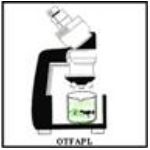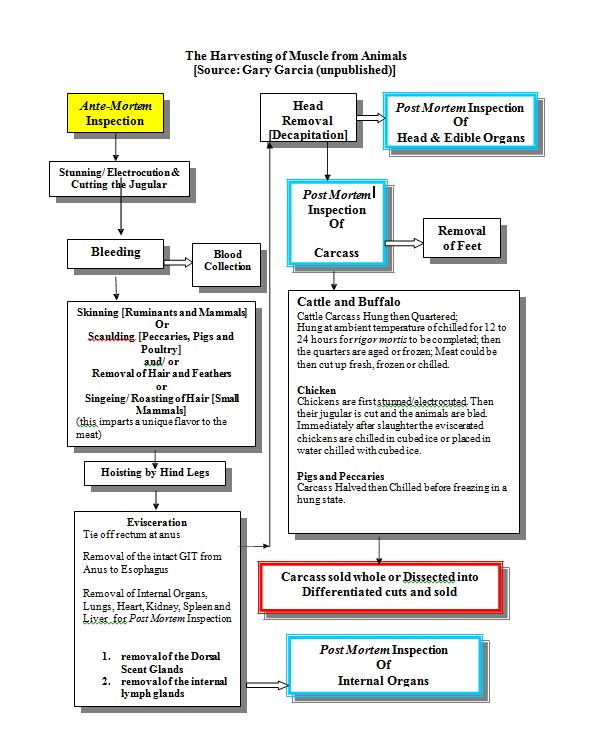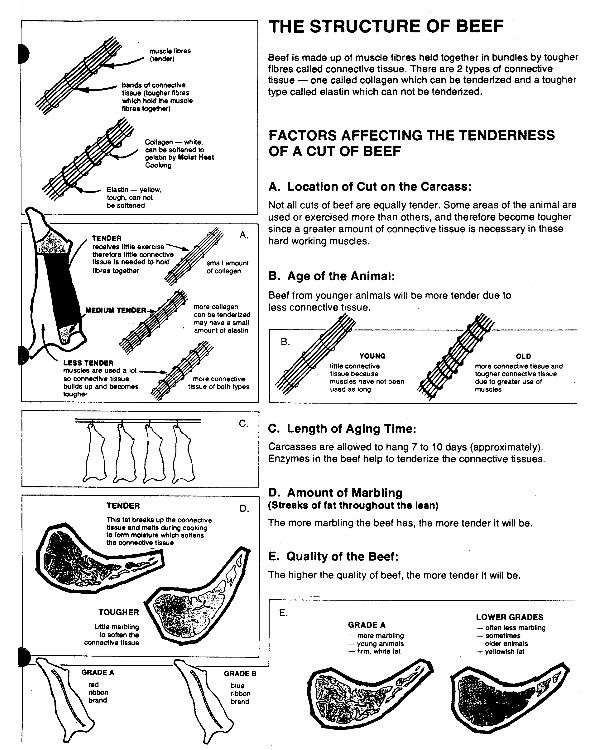
AGLS 2004 - Livestock Products Technology
This section has been written to explain to you how the live animal is transformed from being on the hoof [alive] to meat suitable for human consumption. This would then lead us logically to Peccary Cuisine.
3.1.1.1 The Harvesting of Muscle from Animals
This section attempts to simplify for you the process of converting animal muscles and edible parts into safe and wholesome edible animal products. It should be pointed out here that the unique features of the many Neo-tropical meats are still to be understood. The harvesting of muscle from live animals requires that the animals must first be certified to be of good health, then the animals’ lives must be terminated and finally the meat and other animal products removed from the lifeless animal. Finally, the animal products so harvested must then be certified safe for human consumption. This set of activities can be simplified as follows:
Ante Mortem [AM] Inspection
This is the inspection of the animal 24 hours before slaughter (before the animal is humanely put to death). First there is the external physical examination, the taking of the rectal temperature (to ensure that the animal is in a normal state of health) and the physical examination of the animal to ensure that the animal does not display any obvious signs of disease.
Animal Slaughter
Next in the process flow is animal slaughter. It is the steps involved in taking the animals’ life and safely collecting the products from its lifeless body. Before slaughter, however, the animal must be fasted/or not fed for 24 hours. A very important feature of this process is the live animal entering at one end of the facility to the kill floor, and its parts [containing the parts of the digestive system] coming out in one direction and the edible meat and organs in the opposite direction. This ensures that the edible meat and organs are not contaminated by the faeces or contents of the digestive system.
Post Mortem [PM] Inspection
This involves the inspection of
• the Animal’s Head and Glands around the neck region;
• the Liver
• Kidneys
• Heart and
• The general condition of the carcass.
Figure 3.1.1.1a presents the process flow chart for the general harvesting of muscle from different kinds of animals.

The Conversion of Muscle to Meat
The muscle on the animal at slaughter is a living tissue with complex biochemical and physiological properties. We impose a series of treatments, changing its temperature, tension, and fluid and gaseous environment, and it changes from muscle to meat.
Living muscle tissue
In living muscle, the complete oxidation of carbohydrate to carbon dioxide and water requires the intervention of oxygen, and it releases a lot of energy. Much of this energy is captured by adding a phosphate group to another molecule that already contains two phosphate groups. This chemical in the muscle tissue is called adenosine diphosphate (ADP) and it is converted to adenosine triphosphate (ATP). The ATP molecule carries this energy within the muscle fibre, and it may be released to another biochemical system by cleaving off the added phosphate (ATP →ADP + P). Muscle contraction is a primary user of ATP in the living animal, but substantial amounts of ATP are also used by the membranes around and within the fibre for maintaining ionic concentration gradients.
The muscle tissue after exsanguinations [bleeding]
Once the animal has been exsanguinated, the oxygen present within the muscles is rapidly used up effectively starting the process of converting muscle to meat.
Rigor Mortis
Rigor mortis is a Latin word which means “stiffness to death”. This is the changes in the contraction and relaxation of the muscles of animals that occur after death at ambient temperature. It is simply stated as the temporary stiffening of a body after death. It can also be referred to as the state a body reaches when the oxygen supply to the muscles ceases by the cells but continue to respire without oxygen. In the literature there is no information on the changes that takes place in the muscles of the Peccary after death. We know that rigor mortis affects meat cooking and eating quality in ruminants, and less so in pigs, therefore it may be that the peccary is somewhat in between.
back to top
3.1.1.2 Aging of Meat
Aging of meat is also known as seasoning, ripening or conditioning. This is the practice of holding carcasses or cuts under low controlled temperature and humidity for several days to enhance flavor, to tenderize them and to complete the curing reactions. Game meat or wild meat is aged to tenderize the meat, this occurs when enzymes breakdown or degrade complex proteins in the muscles of the dead animals over time. Figure 3.1.1.2a below presents this relationship.
The meat has to be held cooled at between 1 to 5 ºC. Peccary meat could possibly be aged with the skin on it but the Dorsal Scent Gland must be removed. This is an area of immediately needed research for the Peccary.
Mc Andrew (1993) in his book on the cooking of “Poultry and Game” has suggested the following hanging times for different European Wild animals:
Rabbits: 2-3 days
Hares: 4-5 days
Venison/Deer: 7-12 days.
This type of information is still to be determined, however, for the meats of our neo- tropical wildlife species.
Figure 3.1.1.2a The relationship between meat tenderness and aging

back to top
3.1.1.3 Factors Affecting the Quality of a Cut of Meat (Beef)
Figure 3.1.1.3a presents graphically the known factors affecting the quality of a cut of domestic beef. These factors and their effect on meat quality will now be explained.
• The age of the animal:
Generally the older the animal gets the tougher the meat.
• The sex of the animal:
Generally the meat produced from a mature male is tougher than the meat coming from a young male or female.
• The location of the muscle:
The active muscles tend to be tougher, see the previous figure.
• Aging:
Aged meat is generally more tender.
• Post Mortem Changes- the onset of rigor mortis:
If the carcass is frozen before the completion of Rigor Mortis the meat tends to be tough.
• Method of cutting the meat:
Always cut meat across the muscle or at right angles to the direction of the length of the muscle, when the meat is cut along the length of the muscle when it is cooked it is tough to eat.
• Marbling:
When the cut of meat is well marbled [i.e. when it has fat distributed throughout the muscle] it can be easily baked or grilled. Meat that is not well marbeled must be baked or grilled using moist heat cooking or must have fat or oil added to it during the cooking process. Without the fat or oil the meat would be quite dry when cooked.
The meat of the Peccary is low in fat and there does not seem to be the evidence of marbling.
• Castration:
Generally the meat from castrated males tends to be more tender than the meat from uncastrated males. However, see the note below with respect to the peccary.
A Note on the Effect of Castration on Meat Quality
Coser- Junior et al (2002) reported that castration had no effect on the carcass traits and meat quality of the Collared Peccary. These animals were reared in captivity and were killed at 300 days of age and weighed 17kg live weight. So they were not very old, which could have influenced the meat quality.
Effect of pH on meat quality - water-holding
The pH of meat generally declines after slaughter as the lactate accumulates as a by- product of the process which releases energy in an attempt to keep the cell alive. This also decreases the water holding capacity of the meat.
(yellowdiv)
Lecture Slides 3.1.1 - Harvesting Muscle from Meat
Lecture Slides
-
-
- 1.1.1 Overview of Livestock Production Systems in CARICOM region
- 1.1.2 Importance of ruminants to our economies and to mankind
- 1.1.3 Non-Ruminant Livestock Production
- 1.1.4 The linkage between the production of food from livestock and crop
- 1.1.5 Factors Affecting Livestock Production
- 1.1.6 Types of Livestock Production Systems
-
- 1.2.1 The Tropics Defined
- 1.2.2 The Diversity of the Tropical Environment
- 1.2.3 Climatic factors of prime importance to agriculture and animal production in the Tropics
- 1.2.4 Physical factors of prime importance to agriculture and animal production in the Tropics
- 1.2.5 Some socio-economic considerations of relevance to the Tropics
- 1.2.6 Animal Production in the Tropics: Status and Horizons
- 1.2.7 Features of Tropical Livestock Commodities
-
In this section, we cover:
3.1.1.1 The Harvesting of Muscle from Animals - the process of converting animal muscles and edible parts into safe and wholesome edible animal products basis
3.1.1.2 Aging of Meat - the practice of holding carcasses or cuts under low controlled temperature and humidity for several days to enhance flavor, to tenderize them and to complete the curing reactions
3.1.1.3 Factors Affecting the Quality of a Cut of Meat (Beef) - the known factors affecting the quality of a cut of domestic beef
3.1.1.1 The Harvesting of Muscle from Animals - the process of converting animal muscles and edible parts into safe and wholesome edible animal products basis
3.1.1.2 Aging of Meat - the practice of holding carcasses or cuts under low controlled temperature and humidity for several days to enhance flavor, to tenderize them and to complete the curing reactions
3.1.1.3 Factors Affecting the Quality of a Cut of Meat (Beef) - the known factors affecting the quality of a cut of domestic beef
This section has been written to explain to you how the live animal is transformed from being on the hoof [alive] to meat suitable for human consumption. This would then lead us logically to Peccary Cuisine.
3.1.1.1 The Harvesting of Muscle from Animals
This section attempts to simplify for you the process of converting animal muscles and edible parts into safe and wholesome edible animal products. It should be pointed out here that the unique features of the many Neo-tropical meats are still to be understood. The harvesting of muscle from live animals requires that the animals must first be certified to be of good health, then the animals’ lives must be terminated and finally the meat and other animal products removed from the lifeless animal. Finally, the animal products so harvested must then be certified safe for human consumption. This set of activities can be simplified as follows:
Ante Mortem [AM] Inspection
This is the inspection of the animal 24 hours before slaughter (before the animal is humanely put to death). First there is the external physical examination, the taking of the rectal temperature (to ensure that the animal is in a normal state of health) and the physical examination of the animal to ensure that the animal does not display any obvious signs of disease.
Animal Slaughter
Next in the process flow is animal slaughter. It is the steps involved in taking the animals’ life and safely collecting the products from its lifeless body. Before slaughter, however, the animal must be fasted/or not fed for 24 hours. A very important feature of this process is the live animal entering at one end of the facility to the kill floor, and its parts [containing the parts of the digestive system] coming out in one direction and the edible meat and organs in the opposite direction. This ensures that the edible meat and organs are not contaminated by the faeces or contents of the digestive system.
Post Mortem [PM] Inspection
This involves the inspection of
• the Animal’s Head and Glands around the neck region;
• the Liver
• Kidneys
• Heart and
• The general condition of the carcass.
Figure 3.1.1.1a presents the process flow chart for the general harvesting of muscle from different kinds of animals.

The Conversion of Muscle to Meat
The muscle on the animal at slaughter is a living tissue with complex biochemical and physiological properties. We impose a series of treatments, changing its temperature, tension, and fluid and gaseous environment, and it changes from muscle to meat.
Living muscle tissue
In living muscle, the complete oxidation of carbohydrate to carbon dioxide and water requires the intervention of oxygen, and it releases a lot of energy. Much of this energy is captured by adding a phosphate group to another molecule that already contains two phosphate groups. This chemical in the muscle tissue is called adenosine diphosphate (ADP) and it is converted to adenosine triphosphate (ATP). The ATP molecule carries this energy within the muscle fibre, and it may be released to another biochemical system by cleaving off the added phosphate (ATP →ADP + P). Muscle contraction is a primary user of ATP in the living animal, but substantial amounts of ATP are also used by the membranes around and within the fibre for maintaining ionic concentration gradients.
The muscle tissue after exsanguinations [bleeding]
Once the animal has been exsanguinated, the oxygen present within the muscles is rapidly used up effectively starting the process of converting muscle to meat.
Rigor Mortis
Rigor mortis is a Latin word which means “stiffness to death”. This is the changes in the contraction and relaxation of the muscles of animals that occur after death at ambient temperature. It is simply stated as the temporary stiffening of a body after death. It can also be referred to as the state a body reaches when the oxygen supply to the muscles ceases by the cells but continue to respire without oxygen. In the literature there is no information on the changes that takes place in the muscles of the Peccary after death. We know that rigor mortis affects meat cooking and eating quality in ruminants, and less so in pigs, therefore it may be that the peccary is somewhat in between.
back to top
3.1.1.2 Aging of Meat
Aging of meat is also known as seasoning, ripening or conditioning. This is the practice of holding carcasses or cuts under low controlled temperature and humidity for several days to enhance flavor, to tenderize them and to complete the curing reactions. Game meat or wild meat is aged to tenderize the meat, this occurs when enzymes breakdown or degrade complex proteins in the muscles of the dead animals over time. Figure 3.1.1.2a below presents this relationship.
The meat has to be held cooled at between 1 to 5 ºC. Peccary meat could possibly be aged with the skin on it but the Dorsal Scent Gland must be removed. This is an area of immediately needed research for the Peccary.
Mc Andrew (1993) in his book on the cooking of “Poultry and Game” has suggested the following hanging times for different European Wild animals:
Rabbits: 2-3 days
Hares: 4-5 days
Venison/Deer: 7-12 days.
This type of information is still to be determined, however, for the meats of our neo- tropical wildlife species.
Figure 3.1.1.2a The relationship between meat tenderness and aging

back to top
3.1.1.3 Factors Affecting the Quality of a Cut of Meat (Beef)
Figure 3.1.1.3a presents graphically the known factors affecting the quality of a cut of domestic beef. These factors and their effect on meat quality will now be explained.
• The age of the animal:
Generally the older the animal gets the tougher the meat.
• The sex of the animal:
Generally the meat produced from a mature male is tougher than the meat coming from a young male or female.
• The location of the muscle:
The active muscles tend to be tougher, see the previous figure.
• Aging:
Aged meat is generally more tender.
• Post Mortem Changes- the onset of rigor mortis:
If the carcass is frozen before the completion of Rigor Mortis the meat tends to be tough.
• Method of cutting the meat:
Always cut meat across the muscle or at right angles to the direction of the length of the muscle, when the meat is cut along the length of the muscle when it is cooked it is tough to eat.
• Marbling:
When the cut of meat is well marbled [i.e. when it has fat distributed throughout the muscle] it can be easily baked or grilled. Meat that is not well marbeled must be baked or grilled using moist heat cooking or must have fat or oil added to it during the cooking process. Without the fat or oil the meat would be quite dry when cooked.
The meat of the Peccary is low in fat and there does not seem to be the evidence of marbling.
• Castration:
Generally the meat from castrated males tends to be more tender than the meat from uncastrated males. However, see the note below with respect to the peccary.
A Note on the Effect of Castration on Meat Quality
Coser- Junior et al (2002) reported that castration had no effect on the carcass traits and meat quality of the Collared Peccary. These animals were reared in captivity and were killed at 300 days of age and weighed 17kg live weight. So they were not very old, which could have influenced the meat quality.
Effect of pH on meat quality - water-holding
The pH of meat generally declines after slaughter as the lactate accumulates as a by- product of the process which releases energy in an attempt to keep the cell alive. This also decreases the water holding capacity of the meat.
Figure 3.1.1.3a The Structure of
Beef

back to top
